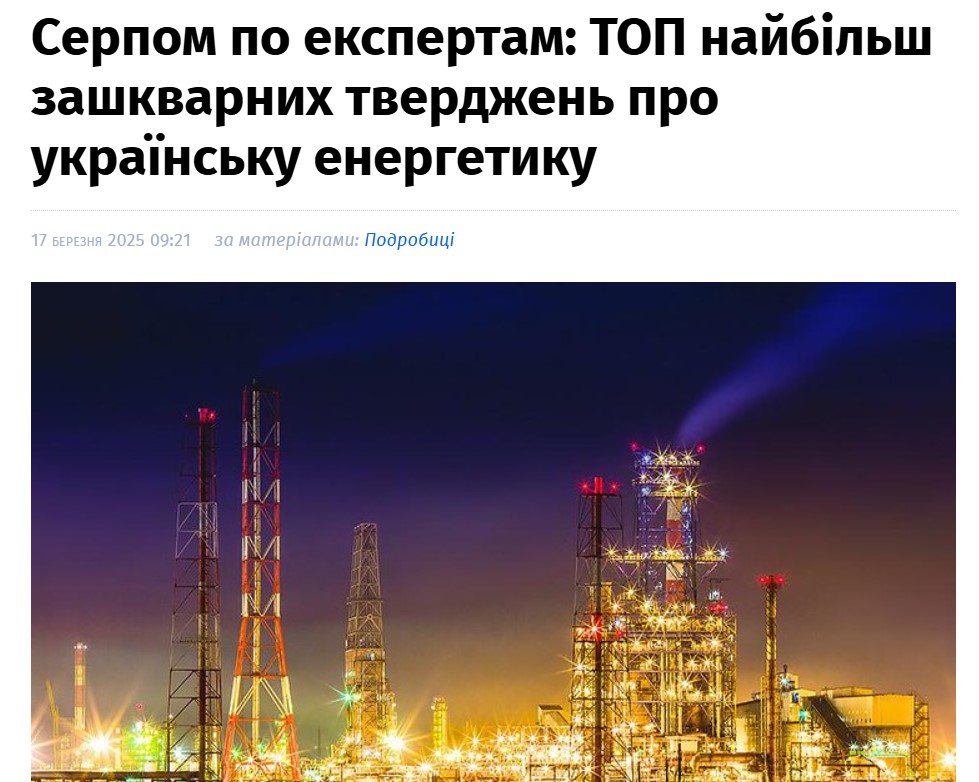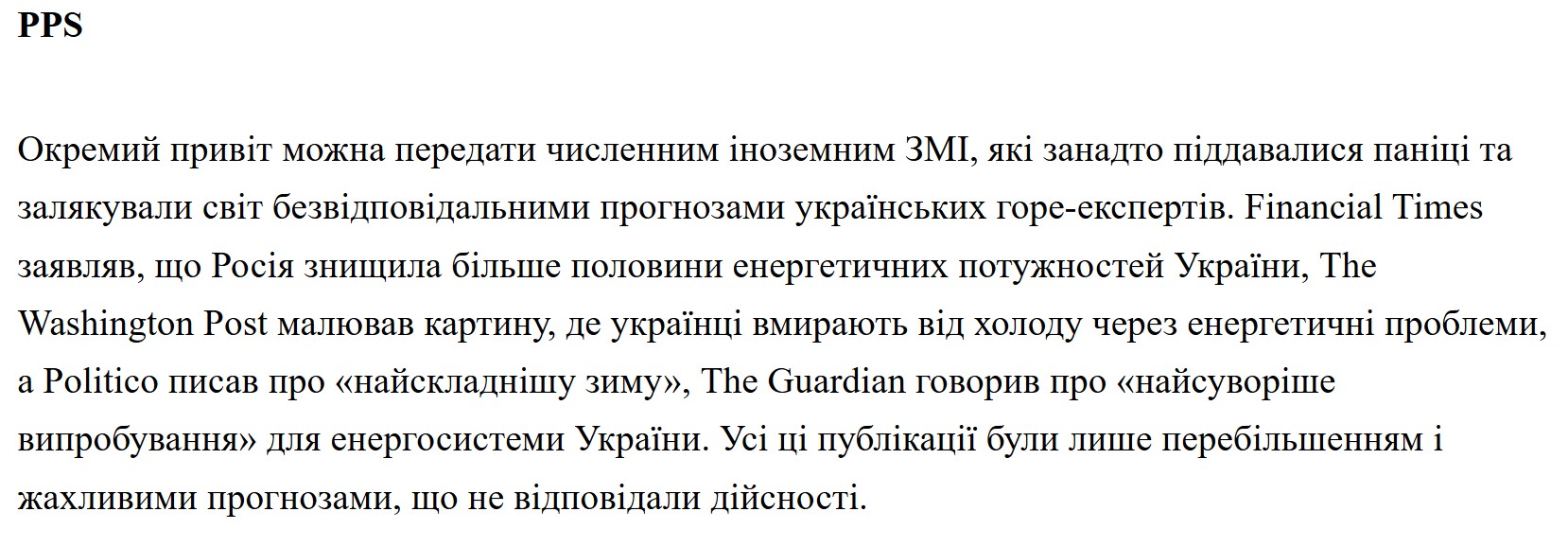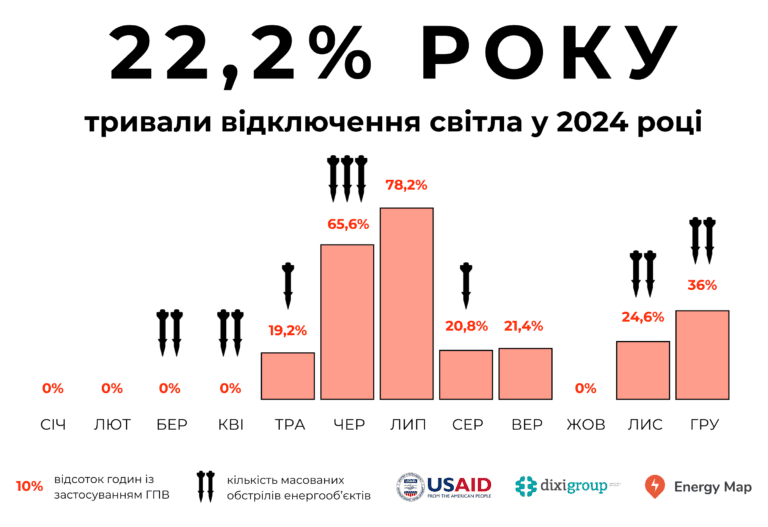On March 17, an article appeared on the “Podrobytsi” website, claiming that energy experts were allegedly “caught” lying. It argued that the forecasts about blackouts in winter did not come true, meaning the experts manipulated and intimidated the public. Later, the article was reposted by other media and Telegram channels. However, don’t be quick to cancel all the experts: the article itself by “Podrobytsi” is full of manipulations.
VoxCheck identified at least three problems in the article: treating forecasts as “magical predictions”, ignoring the context in which the forecasts were made, and selectively quoting experts. Let’s look at how to read forecasts and avoid overreacting with claims that “all experts are incompetent.”



Extracts from Podrobytsi article
Disclaimer. “Podrobytsi” created a ranking of 13 experts whose forecasts did not come true. We do not claim that each of the mentioned speakers was right, never made mistakes, or that their forecasts were 100% accurate.
Instead, we explain that a failed forecast does not equal a lie and check whether the experts’ quotes were taken out of context. “Podrobytsi” promotes the idea that all experts were almost deliberately lying and scaring the public. Discrediting the entire expert community is unconstructive and unlikely to help Ukrainians better understand the news.
Problem #1: Failed forecasts do not equal lies
The authors of the article failed to understand the very logic of forecasting. They equated forecasts to magical predictions that must come true with 100% accuracy. In their view, if a forecast did not fully come true, it automatically means the expert either lied or was incompetent. This approach not only oversimplifies but also distorts the essence of forecasting.
It’s worth starting with the fact that even a weather forecast, which relies on complex mathematical models and data from thousands of weather stations, satellites, weather balloons, and radars, is never absolutely accurate. A weather forecast is just a likely scenario, a scientifically grounded assumption about the future state of the atmosphere, not a “precise future”. Forecasts of social processes are even more complex, as they depend on many variables: economic conditions, the international situation, public expectations, specific political decisions, and even the mood of the people making those decisions. Even the most well-founded forecasts have their limits of accuracy, and a change in any given circumstance can significantly affect the final outcome.
In addition, everyone is wise in hindsight, so it is not entirely correct to evaluate a forecast after the event has already occurred. When an expert makes an assumption, they rely on the data available at that moment, analyze the situation, and assess the risks. If these factors change later, for example, new information emerges, additional measures are taken, or circumstances change, this may make the previous forecast irrelevant. But this does not mean that it was wrong or incorrect from the beginning.
VoxCheck asked for a comment from Olena Lapenko, general manager in the field of security and resilience at DiXi Group. She explained the factors that energy forecasts are based on: “The first and most important is available generation. That is, the amount of electricity that can be provided by nuclear, thermal, hydro plants, and renewable sources. Scheduled repairs, damage from attacks, and recovery potential are taken into account. […] Consumption is forecasted based on historical data, weather conditions (frost or heat increases demand), and economic activity. Also assessed are the possibilities of importing electricity, which depend on the technical limits of transmission lines and demand in Europe. The most difficult aspect now is assessing the probability of new strikes on infrastructure, which can disable generation or networks.”
Indeed, forecasts detached from reality do deserve criticism. If a forecast is based on incorrect or incomplete data, it can and should be fact-checked. For example, if someone claimed that Ukraine would have no electricity supply issues at all during the winter despite massive missile strikes on the energy sector, this would seem, at the very least, shortsighted. By contrast, a forecast of possible blackouts seemed entirely reasonable under conditions of significant damage to the power grid before the cold season and continued shelling.
By the way, at both the state and household level, preparing for a negative scenario is not the worst idea. It’s better to have a power station and use it just a couple of times a month than to have nothing and face winter armed only with optimism.
Problem #2: Ignoring the context in which forecasts were made
Let’s go back in time — autumn 2024. Were there grounds to expect outages in winter? Yes.
Let’s start with the most obvious — Russian terror. Since 2022, Russia has regularly attacked Ukraine’s energy system, and the attacks intensified in the spring of 2024. From September 2022 to September 2024, Russia carried out 25 massive attacks on Ukraine’s energy sector. That’s over 1,400 missiles of various types and 500 attack UAVs. In total, over three years, Russia carried out more than 30 massive attacks on Ukraine’s energy infrastructure, 13 of which happened in 2024.
Let’s not forget about the occupation either. About 18 GW of capacity is unavailable due to the occupation of generation facilities. The occupation of the Zaporizhzhia Nuclear Power Plant alone reduced available capacity by at least 6 GW. Before the invasion, the plant produced about 20% of the country’s electricity.
In total, during 2022–2023, about half of the capacities were either occupied, damaged, or destroyed. And after the spring attacks of 2024, Ukraine was left with a third of its pre-war capacity.
In the summer of 2024, Ukraine experienced a severe electricity shortage, when its generating capacity fell 2.3 GW below the peak demand of 12 GW, despite imports. This was due to intense shelling and scheduled repairs at nuclear power plants. The country managed to overcome this situation precisely thanks to systematic outages. In autumn 2024, during another wave of attacks on the energy system, scheduled outages were resumed and lasted until December 2024. However, the most pessimistic forecasts about 20-hour outages did not come true, mainly due to a mild winter, decreased effectiveness of Russian strikes, government preparedness, and international support.
According to Olena Lapenko, there is an element of unpredictability in forecasts:
“The accuracy of a forecast depends on how accurately these factors can be predicted, but the unpredictability of war and weather often brings adjustments. Therefore, experts rather took a cautious approach, considering worst-case scenarios. Winter showed that the system withstood better than expected, but this is no reason to relax — the vulnerability hasn’t disappeared, and the future depends on many variables that are hard to predict with certainty.”
However, outages did occur, both stabilization and emergency ones. On December 13 and 25, 2024, the 12th and 13th massive attacks took place, respectively, which led to the return of hourly outage schedules, which remained in effect almost until the end of 2024. In December, outages for the population lasted a total of 36% of the month’s hours.
Duration of scheduled power outages in 2024

Source: DiXi Group
Even on March 15, two days before the publication of the “Podrobytsi” ranking, energy facilities in Odesa and Dnipropetrovsk oblasts were damaged by a Russian attack, and some residents were left without power. If the authors of the ranking weren’t affected by the outages, that doesn’t mean they didn’t happen.
Problem #3: Selective quoting
We reviewed the quotes of 13 experts from the “Podrobytsi” ranking. Almost every quote raises questions about its interpretation: in some cases, the journalists ignored the circumstances under which the forecasts were made, and in others, they omitted optimistic or neutral forecasts voiced by the expert in the same statement.
We will demonstrate this selective quoting using the example of five experts.
Oleksandr Kharchenko, Director of the Energy Research Center, 02/09/2024
“A nationwide blackout is still possible. After this attack, it’s clear that it can only happen for one reason. Which the enemy knows very well. A national blackout is a cascading failure when almost all consumers in the country are disconnected, the unified energy system breaks up into separate parts, and people wait for electricity to return for several days.”
In reality, the authors of “Podrobytsi” did not fully understand what Kharchenko meant in his column for Ekonomichna Pravda. One of his key ideas is the analysis of the tactics used by the Russians to destroy Ukraine’s energy system. In particular, he notes that the Russians strike open switchgear at substations. This is critical equipment that transmits electricity from power units to consumers, and its destruction can cause widespread power outages.
According to Oleksandr Kharchenko, this tactic is typical of the Russians. So if they use it, a blackout could occur. At the same time, Kharchenko did not say that it would definitely happen or even specify a time frame. Moreover, in August 2024, the Russians indeed carried out massive attacks on Ukrainian energy facilities, which is why Kharchenko expressed this opinion in early September.
In October, in an interview, the expert said that Ukrainians could face outages, but it all depends on weather conditions, Russian attacks, and how successful they are. But again, he did not mention any specific figures or periods.
Viktoriia Voitsytska, Director of Energy Sector Advocacy at the International Center for Ukrainian Victory, 13/06/2024
“If such massive attacks as we saw throughout March, April, May, and early June continue, if we have a lack of air defense, missile defense systems, and electronic warfare systems, because we still don’t have enough to cover all facilities, we may find ourselves in a situation where we have electricity for four to five hours a day at best.”
Viktoriia Voitsytska indeed said in an interview with NV that Ukrainians could face electricity restrictions. However, before that, she emphasized that many factors affect these restrictions: “There’s such a wide range of ‘from’ and ‘to’. It’s so huge and depends on many factors, starting with the fact that we can’t predict 100% what the enemy’s strategy will be regarding the destruction of our energy system.”
Moreover, she spoke about outages in the context of massive attacks as of June and did not claim that outages would necessarily happen in winter. Although later in the interview, Voitsytska advised people to prepare for the winter of 2024–2025, her point was more about preparing for the worst-case scenario rather than making categorical statements about an inevitable collapse, as “Podrobytsi” tries to portray.
Serhii Kovalenko, CEO of Yasno, 28/06/2024
“Ukrainians could be without power for 12 hours in winter: gloomy forecast from Yasno. According to the CEO of Yasno, Serhii Kovalenko, based on his baseline forecast, Ukrainians could be without power for 12 hours in winter, and in the best case — for 5–6 hours.”
While working on this material, we noticed that “Podrobytsi” deleted Serhii Kovalenko’s quote from their website. However, the original version was saved in an archive. It shows that the journalists of “Podrobytsi” not only ignored the original source and referred to a reprint but also combined quotes from two different interviews. On June 12, 2024, in response to a Forbes Ukraine journalist’s question about power outages, Serhii Kovalenko said that the situation should be viewed in the context of three seasons: summer, autumn, and winter. The situation in winter, in his opinion, depends on electricity imports, nuclear block repairs, and the weather. As of June, the forecast of 5–6 hours of electricity per day seemed quite realistic to him. Nevertheless, Kovalenko emphasized that the situation could improve: “But I think it could be better. It depends on how much we restore, so my forecast for the winter is: you need to prepare based on the assumption that there will be 5–6 hours of power per day. But by the end of August, the forecast should be updated, because we will understand how much generation we have available internally, and then it will be possible to make any calculations mathematically.”
At the end of June, in a comment to Delo.ua, he stated that Ukrainians could be without electricity for 12 hours in winter, but again emphasized that the situation could be better if the energy sector restores everything that is planned and the temperature is favorable. “Podrobytsi” did not take this into account and highlighted only the worst-case forecast, even though the expert also voiced a more positive one, which ultimately came true.
Volodymyr Kudrytskyi, former Chairman of the Board of Ukrenergo, 12/09/2024
“Schedules of four-on-four or four-on-six are possible. It depends on how long the period of severe cold will be.”
In an interview with Ekonomichna Pravda, Kudrytskyi was asked to give a forecast about the electricity situation in winter. Podrobytsi quoted only one statement and did not mention another part of the interview, which provides important context: “My forecast is moderate. In warm periods, when the temperature is above zero, we can manage without outages, unless something happens to generation facilities involving 1000 or 2000 megawatts. If there’s a cold period, for instance, an average daily temperature of minus 10, then I don’t see how we can cover the deficit.”
Kudrytskyi also said in the interview: “If the attacks are like the ones we saw before, there won’t be an apocalypse. In winter, there will be periodic electricity limitations, but the heating and water supply systems, where they are centralized, will continue to operate.”
So, Podrobytsi selectively used only his assumption about a possible blackout schedule, omitting the important context. Moreover, even in the quote used by Podrobytsi, Kudrytskyi doesn’t give categorical forecasts, but merely describes possible scenarios.
Volodymyr Omelchenko, Director of Energy Programs at the Razumkov Center, 22/08/2024
“Planned outages will be unavoidable. On average, I think one or two groups will be tuned off. One group equals 4 hours, two — 8 hours. But on some days it will be less, on others — more. For instance, on weekends, if it’s not too cold, 0…-3 degrees, there might be no outages at all. But on cold days and during peak hours, I think three groups will be introduced, at minimum.”
The accusations from Podrobytsi that Omelchenko’s forecasts range from “no outages at all” to “16-hour blackouts” do not seem reasonable. It was impossible to accurately forecast the electricity situation due to a range of external factors over which Ukrainian energy experts had limited or no control.
Obviously, the risks of a tough winter were real (the scale of energy infrastructure destruction, regular Russian shelling, potential winter frosts), but Omelchenko did not claim that prolonged outages were inevitable.
Moreover, Omelchenko said in this interview: “I hope we’ll be able to obtain enough equipment by and during the autumn-winter period to repair 3 GW of thermal and hydro generation. That’s important. If that goal is achieved, we’ll get through the autumn-winter period much more easily.” That’s exactly what happened — 4 GW of generation was restored in 2024, which helped to get through the winter much more easily than expected.
How to read forecasts?
Forecasts about the summer are ahead: will the heat lead to mass outages, or is Russia planning new strikes on the energy sector? So it’s important not to fall into extremes like “everything will be over in 2–3 weeks”, “everything’s lost”, or “there are no reliable forecasts or experts”.
The main advice: read beyond loud headlines and distorted quotes. When you see a forecast:
- look for the original source: media or bloggers do not always accurately cite the expert and may abuse clickbait;
- consider the context: when was the forecast made, for what time frame, and what data were available at the time of the comment;
- remember that the speaker may present several scenarios: optimistic, neutral, pessimistic, etc.;
- don’t expect the forecast to be 100% accurate: circumstances can change suddenly, and the expert may be wrong;
- a failed forecast doesn’t necessarily mean you’re dealing with a pseudo-expert. You need to weigh all the factors: experience, the expert’s position, whether they comment professionally only on energy or everything from war to economy, whether they previously spread fakes and whether they admit mistakes.
We forecast that this advice will be useful to the audience not only in news about power outages.
Photo: depositphotos.com/ua
Attention
The authors do not work for, consult to, own shares in or receive funding from any company or organization that would benefit from this article, and have no relevant affiliations



